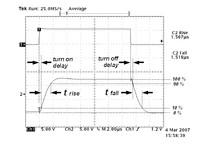Voltage rise rate
The term voltage rise rate stands for changes in a voltage in a characterizing or infinitesimal period of time based on this period of time. This physical variable is preferably used to identify almost sudden changes with correspondingly short periods of time. There are applications of the term rate of rise in voltage in connection with both electrical voltage and mechanical stress . Only the first application is dealt with here; for the second, see.
basis
A sudden change in a system is the idealization of behavior, which is advantageous for many applications. However, any transport of mass or energy takes time, and these quantities cannot be changed suddenly. Rather, there is a transient process for the time behavior of a system after the onset of an external stimulus. As a particularly simple example, a capacitor serves as an energy store , on which the voltage cannot change abruptly because its rate of increase is proportional to the current strength . A jump with an infinitely large increase would require an infinitely large current. When there is an interrelation between two energy stores, vibrations can also occur.
Applications in electrical engineering
In digital technology, rise and fall times describe the times characteristic of a switching process in which the signal no longer has the old and not yet the new defined logic level ("0" or "1") or switching state. The mean rate of rise results from the voltage change from 10% to 90% of the jump height and the associated time change. It is also known as the slope . Short times or steep increases in voltage should avoid the development of transition states. If a continuously changing voltage is to trigger a switching process at a certain value, a Schmitt trigger can be used to achieve the required high rate of rise .
Conversely, thyristors with an ohmic-inductive load are critical with regard to an excessively high rate of voltage rise. If the speed is too high, there is a risk of misfire or destruction. Information in the data sheet on the critical rate of voltage rise must be observed.
Switching processes in the electrical power supply network can trigger overvoltages with very steeply rising " transient " oscillations and high peak values . With a high speed of a voltage change, for example in voltage peaks , a high-frequency energy emission occurs, which can cause disturbances in electronic devices. It is to be countered by measures of electromagnetic compatibility .
With operational amplifiers, there is a maximum possible voltage rise speed at their output, which is referred to as the slew rate . With sinusoidal modulation, the output voltage can never change faster than with the slew rate . For a sinusoidal voltage with is . The maximum value of the frequency for sinusoidal output voltage results from .
Individual evidence
- ↑ Wilfried J. Bartz (Ed.): Ceramic bearings: materials - plain and roller bearings - seals. Expertverlag, 2003, p. 75
- ↑ Hans-Jürgen Christ: Alternating deformation of metals: cyclical stress-strain behavior and microstructure. Springer, 1991
- ^ Herbert Bernstein: Measuring with the oscilloscope. Springer Vieweg, 2nd edition 2016, p. 23
- ↑ Erwin Böhmer: Elements of Applied Electronics. Vieweg, 9th ed. 1994, p. 306
- ^ Ekbert Hering, Klaus Bressler, Jürgen Gutekunst: Electronics for engineers and scientists. Springer, 5th edition 2005, p. 235
- ↑ [1] [2] data sheets, p. 2
- ↑ Leonhard Stiny: Active electronic components . Springer Vieweg, 2nd edition 2015, p. 494









